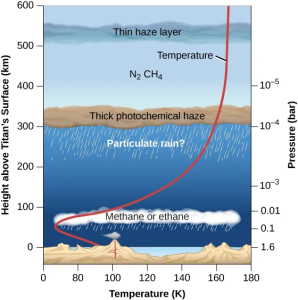8.2 The Large Moons of Saturn and Neptune
We shift our attention now to small worlds in the more distant parts of the solar system. Saturn’s large moon, Titan, turns out to be a weird cousin of Earth, with many similarities in spite of frigid temperatures. The Cassini observations of Titan have provided some of the most exciting recent discoveries in planetary science. Neptune’s moon Triton also has unusual characteristics and resembles Pluto, which we will discuss in the following section.
Titan, a Moon with Atmosphere and Hydrocarbon Lakes
Titan, first seen in 1655 by the Dutch astronomer Christiaan Huygens, was the first moon discovered after Galileo saw the four large moons of Jupiter. Titan has roughly the same diameter, mass, and density as Callisto or Ganymede. Presumably it also has a similar composition—about half ice and half rock. However, Titan is unique among moons, with a thick atmosphere and lakes and rivers and falling rain (although these are not composed of water but of hydrocarbons such as ethane and methane, which can stay liquid at the frigid temperatures on Titan). Titan is the only moon or planet other than Earth where we have found evidence of bodies of surface liquids.
The 1980 Voyager flyby of Titan determined that the surface density of its atmosphere is four times greater than that on Earth. The atmospheric pressure on this moon is 1.6 bars, higher than that on any other moon and, remarkably, even higher than that of the terrestrial planets Mars and Earth. The atmospheric composition is primarily nitrogen, an important way in which Titan’s atmosphere resembles Earth’s.
Also detected in Titan’s atmosphere were carbon monoxide (CO), hydrocarbons (compounds of hydrogen and carbon) such as methane (CH4), ethane (C2H6), and propane (C3H8), and nitrogen compounds such as hydrogen cyanide (HCN), cyanogen (C2N2), and cyanoacetylene (HC3N). Their presence indicates an active chemistry in which sunlight interacts with atmospheric nitrogen and methane to create a rich mix of organic molecules. There are also multiple layers of hydrocarbon haze and clouds in the atmosphere, as illustrated in Figure 8.10.
These Voyager discoveries motivated a much more ambitious exploration program using the NASA Cassini Saturn orbiter and a probe to land on Titan called Huygens, built by the European Space Agency. The orbiter, which included several cameras, spectrometres, and a radar imaging system, made dozens of close flybys of Titan between 2004 and 2015, each yielding radar and infrared images of portions of the surface. The Huygens probe successfully descended by parachute through the atmosphere, photographing the surface from below the clouds, and landing on January 14, 2005. This was the first (and so far the only) spacecraft landing on a moon in the outer solar system.
At the end of its parachute descent, the 319-kilogram Huygens probe safely touched down, slid a short distance, and began sending data back to Earth, including photos and analyses of the atmosphere. It appeared to have landed on a flat, boulder-strewn plain, but both the surface and the boulders were composed of water ice, which is as hard as rock at the temperature of Titan (see Figure 8.11).
The photos taken during descent showed a variety of features, including drainage channels, suggesting that Huygens had landed on the shore of an ancient hydrocarbon lake. The sky was deep orange, and the brightness of the Sun was a thousand times less than sunlight on Earth (but still more than a hundred times brighter than under the full moon on Earth). Titan’s surface temperature was 94 K (−179 °C). The warmer spacecraft heated enough of the ice where it landed for its instruments to measure released hydrocarbon gas. Measurements on the surface continued for more than an hour before the probe succumbed to the frigid temperature.
Views of the Surface of Titan

(a): PIA08427: Mercator Projection of Huygens’s View at Different Altitudes by ESA/NASA/JPL/University of Arizona, NASA Media Licence.
(b): PIA07232: First Color View of Titan’s Surface by NASA/JPL/ESA/University of Arizona, NASA Media Licence.
Titan’s Lakes
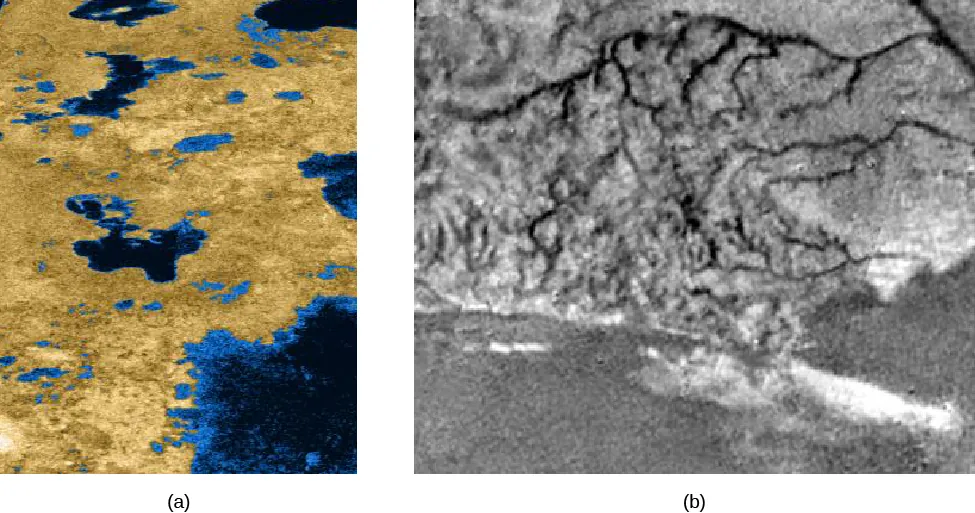
(a): PIA09102: Liquid Lakes on Titan by NASA/JPL-Caltech/USGS, NASA Media Licence.
(b): PIA07236: Mosaic of River Channel and Ridge Area on Titan by NASA/JPL/ESA/University of Arizona, NASA Media Licence.
These discoveries raise the question of whether there could be life on Titan. Hydrocarbons are fundamental for the formation of the large carbon molecules that are essential to life on our planet. However, the temperature on Titan is far too low for liquid water or for many of the chemical processes that are essential to life as we know it. There remains, though, an intriguing possibility that Titan might have developed a different form of low-temperature carbon-based life that could operate with liquid hydrocarbons playing the role of water. The discovery of such “life as we don’t know it” could be even more exciting than finding life like ours on Mars. If such a truly alien life is present on Titan, its existence would greatly expand our understanding of the nature of life and of habitable environments.
NASA has selected a new mission to Titan for launch in 2027. Called Dragonfly, this mission is a drone that will fly in Titan’s atmosphere, with emphasis on study of pre-biotic chemistry. Other future proposed missions include a balloon operating in the atmosphere and a “boat” floating in one of the Titan lakes.
Enceladus
Saturn has a very faint, tenuous ring, called the E Ring, associated with its small icy moon Enceladus. The particles in the E Ring are very small and composed of water ice. Since such a tenuous cloud of ice crystals will tend to dissipate, the ongoing existence of the E Ring strongly suggests that it is being continually replenished by a source at Enceladus. This icy moon is very small—only 500 kilometres in diameter—but the Voyager images showed that the craters on about half of its surface have been erased, indicating geological activity sometime in the past few million years. It was with great anticipation that the Cassini scientists maneuvered the spacecraft orbit to allow multiple close flybys of Enceladus starting in 2005.
Those awaiting the Cassini flyby results were not disappointed. High-resolution images showed long, dark stripes of smooth ground near its south pole, which were soon nicknamed “tiger stripes” (Figure 8.13). Infrared measurements revealed that these tiger stripes are warmer than their surroundings. Best of all, dozens of cryovolcanic vents on the tiger stripes were seen to be erupting geysers of salty water and ice (Figure 8.14). Estimates suggested that 200 kilograms of material were shooting into space each second—not a lot, but enough for the spacecraft to sample.
Enceladus
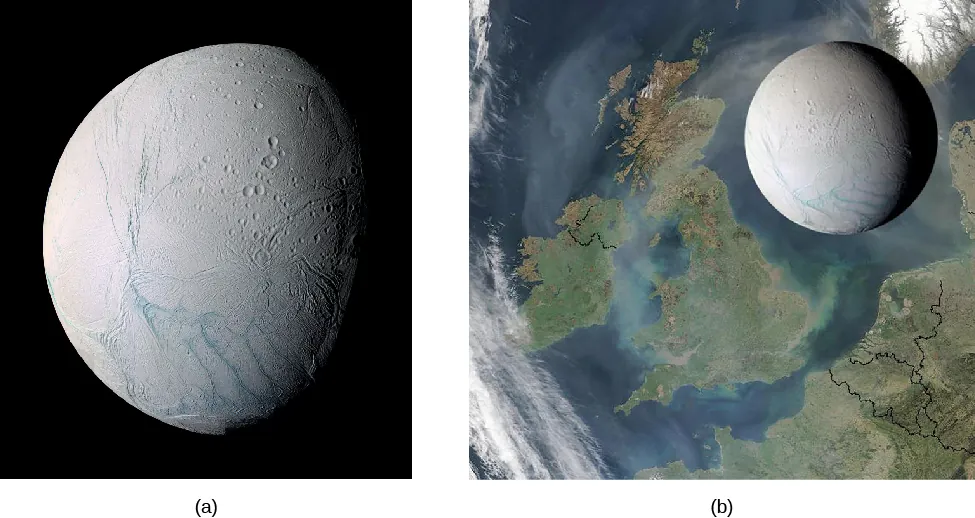
(a): PIA06254: Zooming In On Enceladus (Mosaic) by NASA/JPL/Space Science Institute, NASA Media Licence.
(b): PIA07724: Enceladus to Scale by NASA/JPL/Space Science Institute, NASA Media Licence.
When Cassini was directed to fly into the plumes, it measured their composition and found them to be similar to material we see liberated from comets. The vapour and ice plumes consisted mostly of water, but with trace amounts of nitrogen, ammonia, methane, and other hydrocarbons. Minerals found in the geysers in trace amounts included ordinary salt, meaning that the geyser plumes were high-pressure sprays of salt water.
Based on the continuing study of Enceladus’ bulk properties and the ongoing geysers, in 2015 the Cassini mission scientists tentatively identified a subsurface ocean of water feeding the geysers. These discoveries suggested that in spite of its small size, Enceladus should be added to the list of worlds that we would like to explore for possible life. Since its subsurface ocean is conveniently escaping into space, it might be much easier to sample than the ocean of Europa, which is deeply buried below its thick crust of ice.
Geysers on Enceladus
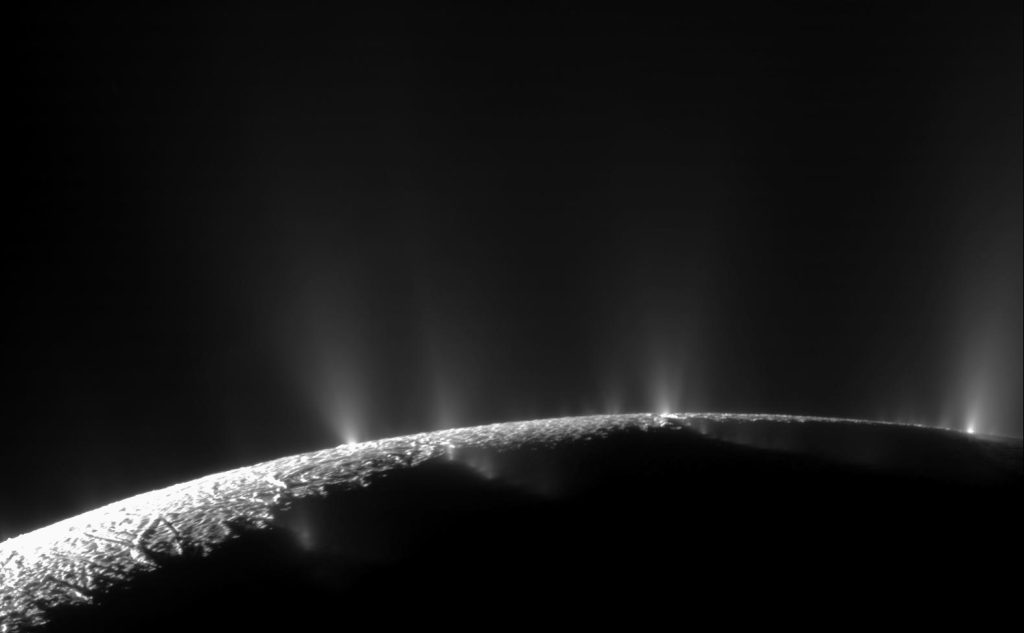
PIA11688: Bursting at the Seams: the Geyser Basin of Enceladus by NASA/JPL/Space Science Institute, NASA Media Licence.
Triton and Its Volcanoes
Neptune’s largest moon Triton (don’t get its name confused with Titan) has a diameter of 2720 kilometres and a density of 2.1 g/cm3, indicating that it’s probably composed of about 75% rock mixed with 25% water ice. Measurements indicate that Triton’s surface has the coldest temperature of any of the worlds our robot representatives have visited. Because its reflectivity is so high (about 80%), Triton reflects most of the solar energy that falls on it, resulting in a surface temperature between 35 and 40 K.
The surface material of Triton is made of frozen water, nitrogen, methane, and carbon monoxide. Methane and nitrogen exist as gas in most of the solar system, but they are frozen at Triton’s temperatures. Only a small quantity of nitrogen vapor persists to form an atmosphere. Although the surface pressure of this atmosphere is only 16 millionths of a bar, this is sufficient to support thin haze or cloud layers.
Triton’s surface, like that of many other moons in the outer solar system, reveals a long history of geological evolution (Figure 8.15). Although some impact craters are found, many regions have been flooded fairly recently by the local version of “lava” (perhaps water or water-ammonia mixtures). There are also mysterious regions of jumbled or mountainous terrain.
Neptune’s Moon Triton
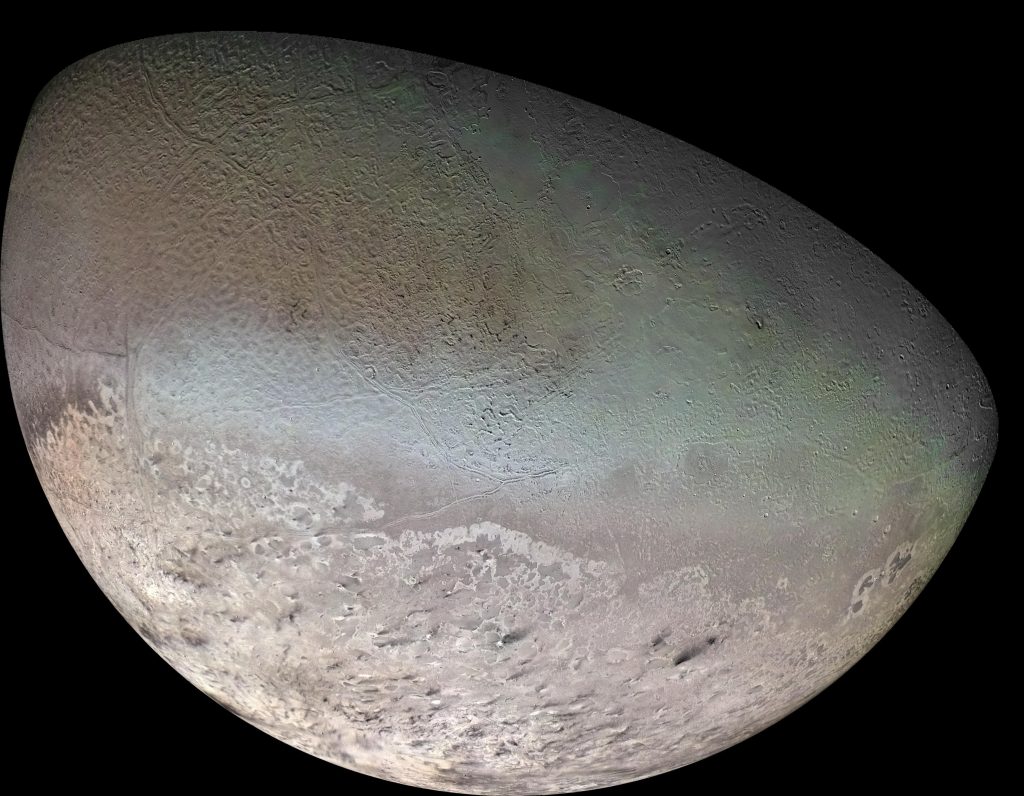
PIA00317: Global Color Mosaic of Triton by NASA/JPL/USGS, NASA Media Licence.
The Voyager flyby of Triton took place at a time when the moon’s southern pole was tipped toward the Sun, allowing this part of the surface to enjoy a period of relative warmth. (Remember that “warm” on Triton is still outrageously colder than anything we experience on Earth.) A polar cap covers much of Triton’s southern hemisphere, apparently evaporating along the northern edge. This polar cap may consist of frozen nitrogen that was deposited during the previous winter.
Remarkably, the Voyager images showed that the evaporation of Triton’s polar cap generates geysers or volcanic plumes of nitrogen gas (see Figure 8.16). (Fountains of such gas rose about 10 kilometres high, visible in the thin atmosphere because dust from the surface rose with them and coloured them dark.) These plumes differ from the volcanic plumes of Io in their composition and also in that they derive their energy from sunlight warming the surface rather than from internal heat.
Triton’s Geysers

PIA00059: Triton South Polar Terrain by NASA/JPL, NASA Media Licence.
Attribution
“12.3 Titan and Triton” and “12.5 Planetary Rings (and Enceladus)” from Astronomy 2e by Andrew Fraknoi, David Morrison, Sidney C. Wolff, © OpenStax – Rice University is licensed under a Creative Commons Attribution 4.0 International License, except where otherwise noted.

